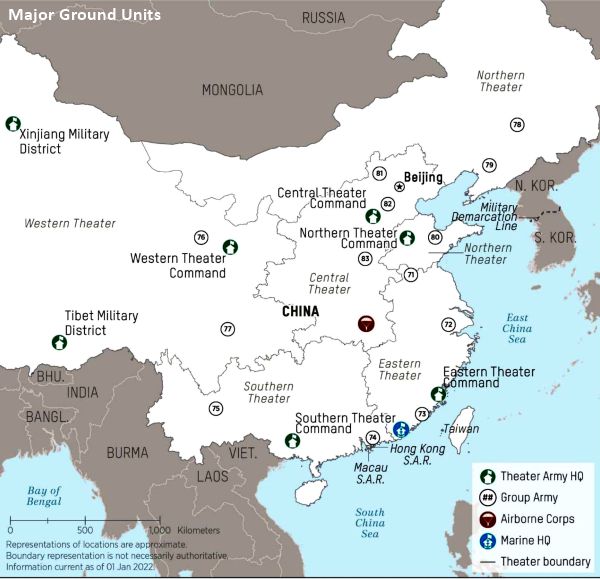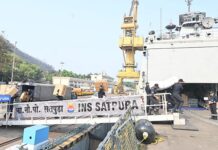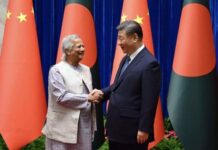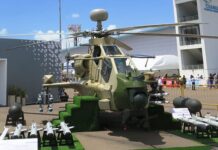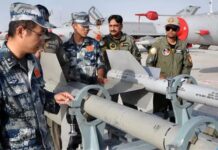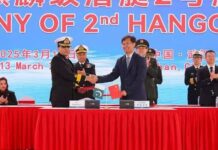Key Takeaways:
• The PLAA emphasized realistic training scenarios and standardization of training methods during the exercise STRIDE-2021 and throughout extensive joint amphibious training that utilized both PLAN and civilian roll-on roll-off (RORO) vessels.
• The PLAA and Russian Army units participated in ZAPAD/INTERACTION-2021, a large-scale joint exercise to expand cooperation between the two militaries, which was conducted on PRC soil for the first time.
• The PLAA applied twice a year conscription after delays from COVID-19 in 2020, emphasizing the recruitment of college graduates and students with science, technology, engineering, and mathematics (STEM) backgrounds.
The PLA Army (PLAA) has approximately 975,000 active-duty personnel in combat units and is the primary ground fighting force in the PLA. The 2020 PRC National Defense University’s Science of Military Strategy described the PLAA’s development as a transition from a regional defense force to a global combat force. In 2021, the PLAA continued to emphasize the modernization and standardization of their equipment through the fielding of new and upgraded combat systems. 2021 also highlighted standardization of training, improvements to power projection capabilities, and extensive combined-arms and joint trainings.
Force Structure and Organization. In 2021, the PLAA continued to field a large number of new platforms and updated equipment. The major force restructuring required by the 2016 and 2017 PLA reforms is complete, but significant additional equipment fielding is necessary to complete the transformation of the PLAA into a fully modern force.
The PLAA is organized into five Theater Army Commands, the Xinjiang military command, and the Tibet military command. The PLAA has 13 group armies, which are comprised of multiple combined-arms brigades that serve as the PLAA’s primary maneuver force. The brigades vary in size and composition. The PLAA delineates its combined-arms brigades into three types: light (high-mobility, mountain, air assault, and motorized), medium (wheeled armored vehicles), and heavy (tracked armored vehicles), with sizes ranging from approximately 4,000 (light) to 5,000 (heavy) personnel each. Each group army controls six additional brigades responsible for operational element functions: an artillery brigade, an air defense brigade, an army aviation (or air assault) brigade, a special operations forces (SOF) brigade, an engineer and chemical defense brigade, and a sustainment brigade. Some variations exist with at least one group army per theater separating their engineering and chemical defense brigades into separate units. Although the PLAA has standardized its group armies, it does retain a number of nonstandard divisions and brigades that exist outside of the group armies. These units are typically located in areas the CCP considers sensitive including Xinjiang, Hong Kong, and Beijing.
Capabilities and Modernization. Despite the PLAA’s ambitions to become a highly modernized ground force they still widely employ a mix of modern and obsolete tanks and armored fighting vehicles. Throughout 2021, the PLAA continued to test and field new systems with a large emphasis on the development of situational awareness and manned unmanned teaming (MUM-T) with the proliferation of vertical takeoff and landing (VTOL) and fixed-wing uncrewed aerial systems (UAS). Soldier enhancement capabilities have also taken the next step as units are beginning to use exoskeletons and hyperbaric oxygen therapy to mitigate stresses on the individual soldier. A ground force with these capabilities, supported by sufficient lift and sustainment capabilities, would likely be able to project at least limited ground power regionally. The PLAA also continued the fielding of light, highly mobile systems with emphasis on areas with difficult terrain.
The PLAA is rapidly developing a limited capability to project ground power as an expeditionary force. In addition to protecting national sovereignty and security, the 2020 National Defense University’s Science of Military Strategy describes the PLAA as focused on improving precision, multi-functional, and sustained operations capabilities, command and control, and integrated systems to promote ambitions of building a global combat capable army. The PLAA’s primary power projection initiatives are mobile, modular combined arms formations, special operations forces, and PLAA Aviation and Air Assault units.
After years of substantial reform, the combined-arms battalion of the combined arms brigade is the basic combat unit of the PLAA. PLAA officers tell PRC media that the formations comprise more than 10 different combat arms, are plug-and-play and adjustable based on the terrain and mission requirements. The PLAA enhanced power projection capabilities through increased mobility, ease of transport and logistics, and precision strike capabilities. This was accomplished through an effort to lighten PLAA with a focus on medium and light, high mobility platforms, and the fielding of new long-range multiple rocket launcher systems.
The PLAA’s 15 Special Operations Forces (SOF) brigades provide group army commanders with an organic unit capable of executing special operations. Typical PLAA SOF brigade missions include raids, harassment operations, target seizure and control, special reconnaissance, precision strike guidance, and rescue operations. Observed SOF training in 2021 included aerial infiltration, small-unit tactics, and maritime operations.
PLAA Aviation and Air Assault units remained a focus of development in 2021. PLAA training events and reports in PRC media show that air-ground integration, multi-dimensional assaults, and MUM-T are now a standard part of training. Training in 2021 also included numerous examples of helicopters executing nighttime flight operations and ultra-low altitude flying. PLAA Aviation works directly with ground units to enhance its ability to support air assault operations and conduct air strikes. Highlights from PLAA Aviation joint training in 2021 included the army aviation helicopters conducting confrontational training against PLAAF surface-to-air missile brigades, and army aviation helicopters coordinating with PLA Navy landing ships. The two PLAA Air Assault brigades continued extensive training on helicopter insertion, air reconnaissance, and coordinating air strikes with other PLAA units and joint service partners. In 2021, PLAA Aviation Brigades began using the new Z-20 medium-lift transport helicopters for various missions in western China. Ongoing development of PLAA Aviation and Air Assault units will lead to a highly-mobile, modular ground force unit capable of supporting expeditionary operations. Expeditionary operations where PLA seeks to improve proficiency include: the protecting of overseas PRC citizens and overseas PRC economic interests, UN Peacekeeping Operations (UN PKO), Humanitarian Assistance and Disaster Relief (HA/DR), Noncombatant Evacuation Operations (NEO), Counterterrorism Operations (CT), and the ability to secure strategic lines of communication (SLOCs) far from the PRC mainland. The PLAA envisions its Aviation and Air Assault units employing their three-dimensional maneuver, firepower, and assault capabilities to act as a main combat force, support a greater joint operation, or conduct non-war military operations outside China. Overseas military operations is comprised of surveillance implementation, seizure, electronic combat, and battlefield rescue, while overseas non-combat operations include disaster relief, emergency rescue, and anti-terrorism.
Readiness. PLAA training in 2021 followed the trend from 2020, focusing on combined-arms and joint training. PLAA units conducted multiple iterations of STRIDE-2021 in various theaters with an emphasis on setting the standardization of training methods and conditions. PLAA units stressed realistic training, professionalization of opposing force (OPFOR) formations, and conducted numerous force-on-force “confrontation drills.”
In addition to conventional ground force training, PLAA units conducted extensive specialty exercises in 2021. Units conducted coastal defense, multiple sea crossings and landings, and high-elevation plateau operations. Joint training included for the first time, ZAPAD/INTERACTION-2021, where PLAA units conducted a large-scale exercise with the Russian military in China. PLAA and Russian forces participating in ZAPAD/INTERACTION-2021 underwent theoretical and systems training, weapon swaps, and a culminating exercise to further understanding and cooperation between the two militaries. The PLAA also continued extensive joint training using PLAN landing ships and civilian RORO vessels to expand amphibious capabilities.
While continuing to focus on equipment modernization, the PLAA also turned to the development of their personnel. The PLAA changes in their recruitment strategy as the PLA implemented a twice a year conscription and increased its emphasis on the recruitment of college students majoring in science and engineering. The PLAA also emphasized the use of simulations in exercises to carry out immersive training in lieu of actual combat training. Use of simulations gives users an emulation of a battlefield that provides a variety of training situations to allow for completion of instruction and mitigation of shortcomings in a low risk environment.
Based on the Annual Report by the Secretary of Defense to U.S. Congress: Military and Security Developments Involving the People’s Republic of China, 2022


